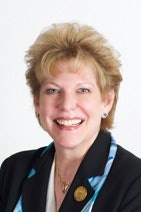 Linda Hallman, American Association of University Women executive director, says she hopes the news “is a wake-up call.”
Linda Hallman, American Association of University Women executive director, says she hopes the news “is a wake-up call.”While the newly released U.S. Census Bureau report on income and poverty rates in the United States shows a persistent gender gap in earnings with women lagging behind men, educational attainment paints a different picture.
On college campuses throughout the country, women typically outnumber men—especially in the African-American community. Even with college degrees working in favor of women, there is a distinct disparity in translating education into income.
According to the report, the data show that, for 2011, there were 58 million men who were year-round, full-time employees compared to 43.7 million women. Men who worked full time, all year round had average earnings of $48,202. For women the average earnings for year-round, full-time workers were $37,118. Women on average earned about 77 cents on the dollar compared to men.
“The bias is still there. There is not a state in the union that pays women dollar for dollar what they pay men,” says Dr. Dennis Kimbro, a Clark-Atlanta University School of Business faculty member and internationally known author and speaker on building wealth. “There are a number of factors such as the good-old-boy network and how women network. The progression model must change. Managers must be held accountable.”
Last year, the Census Bureau reported that, for the first time in American history, there were a million more female college graduates than male. In 2000 it was the opposite: There were a million more men than women with a bachelor’s or graduate degree. For all types of higher education, the number of women earning degrees is rising faster than the number of men earning the same degrees.
But for all the gains in education, a gap persists in the marketplace when it comes to earnings.
Kimbro also notes challenges in corporate America, where more women are leaving to start businesses where they believe the playing field is more level, and even new graduates are bypassing traditional jobs to jump into entrepreneurship. Women-owned businesses are among the fastest growing in the nation.
“Only about 22 Fortune 500 companies are led by women, such as Avon, Hewlett-Packard and Xerox,” says Kimbro, who has a new book coming out, titled The Wealth Choice: Success Secrets of Black Millionaires.
“Diversity is no longer a question of should I comply. Everybody must have a place at the table,” Kimbro adds.
Without improved pay equity, women at all levels are being adversely impacted.
The Census Bureau also reported that women were more likely to live in poverty than men. In 2011, 16.3 percent of all women in the United States were poor, compared to 13.3 percent of men.
“We’re not making any real progress—the gender-wage gap essentially has not budged for a decade. And the problem is worse for African-American women and Latinas,” says American Association of University Women (AAUW) Executive Director Linda D. Hallman. “We hope that this news serves as a wake-up call. If we keep going at this pace, women will never earn the same amount that men earn for full-time, year-round work.”
According to the Census, the gender gap in poverty rates increases as women get older. For women over the age of 65, 10.7 percent of women were poor, compared to 6.2 percent of men. More than 31 percent of families with a woman as a single parent were classified as poor in 2011. For families with a man as a single parent, 16.1 percent were poor in 2011. For married-couple families, only 6.2 percent were poor.
AAUW has been at the forefront of research and advocacy on pay equity for many decades. This fall, AAUW will release new research on the pay gap that women face just one year after college graduation.
“Year after year, the Census Bureau and the Bureau of Labor Statistics release data showing that women working full time earn significantly less money than their male peers. AAUW research delves deeper and shows that, even after controlling for education, occupation, work hours and other factors that are known to affect earnings, an unexplained wage gap still exists,” says Christianne Corbett, the lead author of the forthcoming report.
AAUW has been among the groups leading the charge for stronger pay equity legislation. The association lobbied during the fall of 2010 and again in the summer of 2012 for the Paycheck Fairness Act, which failed in procedural votes in both the Senate and House.





















